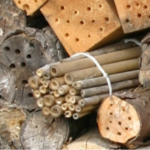
Unlike social bee species, who live together with many other bees in hives, solitary bee species live on their own. These bees like small, tight spaces, where their babies are protected from predators. Some, like Mining Bees, dig holes in the ground, and others, like Carpenter Bees, live in holes in wood! We can help out our Carpenter Bee friends by making special bee hotels just for them!

This activity requires adult supervision and support.
Materials:
- Pieces of wood (logs or scrap pieces of lumber both work great)
- Safety glasses
- Drill bits (3/8 to 1/2 inch are ideal)
- Coloured yarn or string
Directions:
- Collect logs or lumber scraps. Carpenter Bees prefer unpainted, weathered wood, especially softer varieties such as redwood, cedar, and pine.
- With adult supervision/support, drill a series of holes approximately 5-6 cm deep into the face of the logs or lumber. Try to leave at least 8 cm of space between holes (you might only have room for 1-3 holes in your bee hotel).
- Decorate your bee hotel by wrapping the outside of the log or lumber with beautiful yarn or string.
- Place your bee hotel outdoors, somewhere that is partially sheltered from rain. Under roof overhangs or in pergola structures are great places to set up your bee hotel.
For a power tool-free alternative: Try bundling hollow stalks (like sunflower stalks) together and placing them in a sheltered space. A solitary bee (like a leafcutter bee or mason bee, might think it’s the perfect place to settle down!
Go to PAGE 8 for some info about the Hummingbird Clearwing Moth!

